|
| |
Back to Fighters
|
|
The SPAD VII was built by the Societe pour
l'Aviation et ses Derives in France during the first world war. Its
180hp Hispano-Suiza engine gave it a top speed of 130mph and range
of 220 miles - very capable for its day. It first flew in April
1916, and over 6,000 were built. It is a single seater, armed with a
single 0.303 inch Vickers machine gun, synchronised to fire through
the propeller. It is quite a compact machine, 19 feet 9 inches long,
spanning 25 feet 5 inches. Gross weight is 1,550lb.
This one is preserved in the museum at Duxford,
where it was pictured in Summer 2005. |
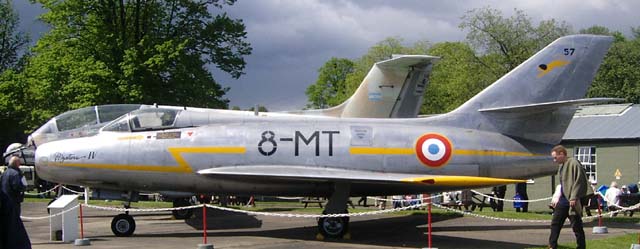 |
The Dassault Mystere IVA was one of the first
fighters produced by France after the second world war. The Dassault
company was a re-foundation of the pre-war Bloch company, whose
founder, Marcel Bloch, had been active in the French Resistance
under the code-name `d'Assault'. The Mystere was a capable fighter,
contemporary with the American F-86 and Russian MiG-17. It first
flew in September 1952. 420 were built for several air forces,
mainly the French. Initially, they were powered by a single
Rolls-Royce Tay turbojet. This one is in
the museum at Duxford, pictured there in Spring 2005. |
|
|
The Dassault Super Etendard is a French
fighter designed specifically for operation from aircraft carriers.
It first flew in 1978. It is powered by a single Snecma Atar
turbojet. It was developed from the earlier (1962) Etendard. It has
two fixed 30mm cannon but can also carry a variety of stores and
weapons on underwing pylons. Top - Super Etendard demonstrating a carrier landing at Yeovilton in July
1986. Bottom - Super Etendard at
Fairford, July 2005 |
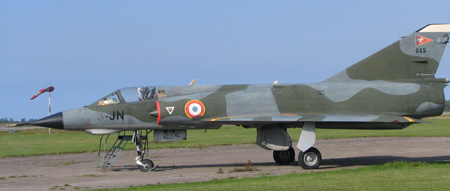 |
The Dassault Mirage IIIE was the major
fighter version of Dassault's famous delta-wing fighter. The first
Mirage flew in June 1955, with this variant flying in April 1961.
420 of this version were built, of which 252 were delivered to the
French Armee de l'Air. It is a single seater, armed with two 30mm
cannon and able to carry up to 6,900lb of mixed stores on its
underwing hardpoints. Its 14,080lb Snecma Atar turbojet gave it a
top speed of 1,460mph but the huge fuel consumption limited the
range to only 475 miles. Gross weight is 29,700 lb. It is 48 feet 10
inches long, with a wing span of 26 feet 9 inches.
Calais, September 2005 |
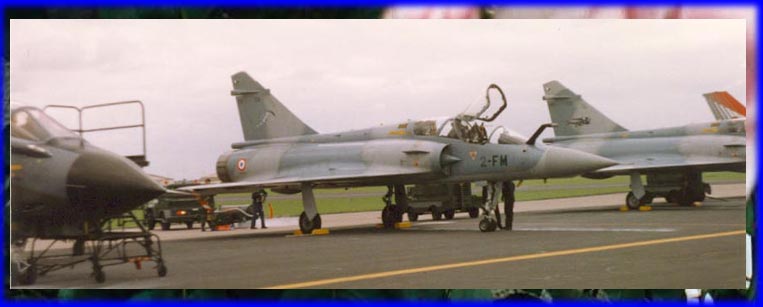 |
The Dassault Mirage 5 was an update of the
earlier Mirage III. It was intended mainly for export, having been
ordered by many countries, especially in Europe and the Middle East.
The French air force bought them later, to replace ageing Mirage
IIIs. The Mirage 5 first flew in May 1968. Top speed is mach 2.1
(twice the speed of sound) at high altitude.
This French two seater was pictured at
Mildenhall, date unknown. |
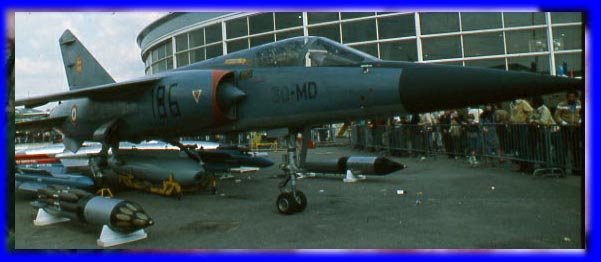 |
The Dassault Mirage F1 differs from the rest
of the Mirage range in having a small, shoulder mounted wing. It is
intended as a multi-role fighter aircraft. It is faster, but carries
less load, than the Mirage 5 series. The F1 first flew in December
1966. Several hundred have been built. They are in service both with
the French and many other countries. Like the Mirage 5, it is
powered by a Snecma Atar turbojet. This
one was at Paris - Le Bourget in 1979. |
|
|
The Dassault Mirage 2000 is a major upgrade
of teh Mirage 3/5 series, designed to replace the earlier models
with the French forces and to rival the American F-16 in export
markets. It has been quite successful, with 516 delivered. mainly to
France, but also to Egypt, Greece, India, Peru, Qatar, Taiwan and
the United Arab Emirates. Its 12,230lb Snecma M-53 engine gives it a
top speed of 1,450mph and range of 920 miles. First flown in March
1978, it was one of the early users of relaxed stability techniques
to enhance manoeuvrability. it is armed with two cannon and can
carry up to 13,900lb of mixed stores on nine external pylons. Gross
weight is 37,500lb; length, 47 feet 1 inch; wing span, 29 feet 11
inches.
Top - Mirage 2000B two seat conversion trainer.
Bottom - Mirage 2000C.
Pictures at Fairford, July 2005. |
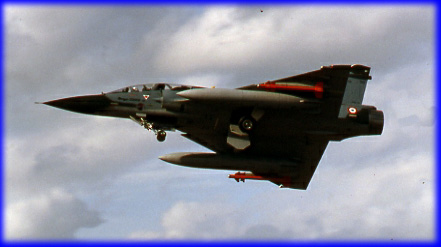 |
The Dassault Mirage 2000N is designed as the
replacement for France's Mirage 4 nuclear bomber. It is a large
aircraft with a very large load carrying capability, with the
familiar Mirage shape. This version is a two seater as standard
(other Mirage variants are only two seaters in their training
derivatives). This one was seen shortly
after its first flight, at Farnborough in September 1984. |
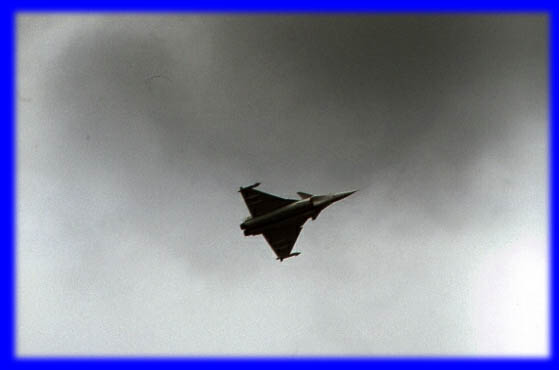 |
This rather distant picture shows a Dassault Rafale
flying past at Farnborough in 1986. The Rafale is an advanced,
fly-by-wire, high manoeuvrability fighter intended as a successor to
the Mirage 5 series of fighters. The cost limits its export
potential. It is in service with the French Armee de l'Air. It is a
twin engined design, with canard foreplanes to assist agility, and
some limited stealth characteristics. |





|